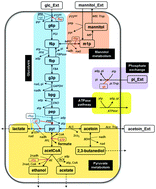An extended dynamic model of Lactococcus lactis metabolism for mannitol and 2,3-butanediol production†
Abstract
Biomedical research and biotechnological production are greatly benefiting from the results provided by the development of dynamic models of microbial metabolism. Although several kinetic models of Lactococcus lactis (a Lactic Acid Bacterium (LAB) commonly used in the dairy industry) have been developed so far, most of them are simplified and focus only on specific metabolic pathways. Therefore, the application of mathematical models in the design of an engineering strategy for the production of industrially important products by L. lactis has been very limited. In this work, we extend the existing kinetic model of L. lactis central metabolism to include industrially relevant production pathways such as mannitol and 2,3-butanediol. In this way, we expect to study the dynamics of metabolite production and make predictive simulations in L. lactis. We used a system of ordinary differential equations (ODEs) with approximate Michaelis–Menten-like kinetics for each reaction, where the parameters were estimated from multivariate time-series metabolite concentrations obtained by our team through in vivo Nuclear Magnetic Resonance (NMR). The results show that the model captures observed transient dynamics when validated under a wide range of experimental conditions. Furthermore, we analyzed the model using global perturbations, which corroborate experimental evidence about metabolic responses upon enzymatic changes. These include that mannitol production is very sensitive to lactate dehydrogenase (LDH) in the wild type (W.T.) strain, and to mannitol phosphoenolpyruvate: a phosphotransferase system (PTSMtl) in a LDH mutant strain. LDH reduction has also a positive control on 2,3-butanediol levels. Furthermore, it was found that overproduction of mannitol-1-phosphate dehydrogenase (MPD) in a LDH/PTSMtl deficient strain can increase the mannitol levels. The results show that this model has prediction capability over new experimental conditions and offers promising possibilities to elucidate the effect of alterations in the main metabolism of L. lactis, with application in strain optimization.


 Please wait while we load your content...
Please wait while we load your content...